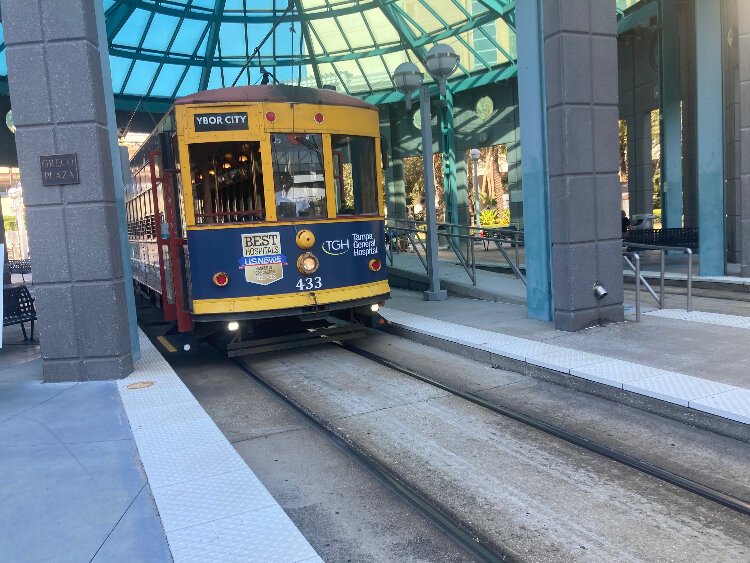In Tampa, a desire to expand a streetcar named TECO
Tampa's TECO Line Streetcar celebrates its 20th anniversary as the country's second-busiest streetcar system, with an expansion plan that waits on funding to become reality.
Tampa’s TECO Line Streetcar celebrated its 20th anniversary in October, a two-decade span of explosive growth for the streetcar system and the downtown through which it runs.
In an October 28th ceremony at the Dick Greco Plaza transit hub, Tampa Downtown Partnership President and CEO Lynda Remund recalls how the streetcar line, which runs between the area near the Tampa Convention Center and Ybor City, started as a tourist attraction and evolved into an everyday way to get around for residents and workers in the downtown and Ybor areas.
Intertwined with the streetcar’s growth, Tampa’s Channel District and downtown riverfront transformed into mixed-use hubs of activity, attracting new residents, companies and retail and restaurant options at a pace that’s placed the city on the national stage.
Today, the TECO Line’s vintage-style electric trolley cars carry more than one million passengers a year, second in the country to only Kansas City. This September, the streetcar drew more than 76,000 riders, Tampa Mayor Jane Castor says during the anniversary ceremony, a September record for the system.
With the success of the fare-free system and Tampa’s rapid growth, there’s a plan in place to expand the streetcar and link it to a larger public transit network that includes bus rapid transit. The “sticking point,” Castor says in her comments, is funding.
“Blood, sweat and tears”
During her comments, Castor notes the “blood, sweat and tears” that have gone into launching and building the TECO Line.
In 1984, the Tampa and Ybor City Street Railway Society formed to launch a public campaign to bring back an electric streetcar system like the one that ran through Tampa from 1892 to 1946, reaching its peak in the 1920s.
Tampa Historic Streetcar Board of Directors President Michael English has been part of the effort since the early days.
”It’s hard to believe I’ve been involved since 1986 in this,” English says at the ceremony. “It’s been a pleasure, but it’s been amazing. The Streetcar Society worked very hard to make the streetcar come to fruition.”
The breakthrough, English says, was when former Mayor Dick Greco, for whom the streetcar hub downtown is now named, met with advocates and committed to fund the development of the system. At the ceremony, English presents Castor with a vintage streetcar conductor hat and praises the current mayor’s support for the TECO Line.
“Thanks to a serious city administration and a brilliant transportation planning staff we have plans to move forward and extend the streetcar,” he says.
A solution for affordable housing, transportation and workforce development
At the ceremony, Castor notes that affordable housing, transportation options and workforce development are priority issues for Tampa’s continued success.
“If you look at the streetcar it plays a pivotal role in all three of those,” she says.
With mortgages and rents rising, the free streetcar gives some workers the option of going without a car and a car payment, freeing up money. The expansion of the streetcar and the larger transit network can also allow people to live in areas where housing costs meet their budget and conveniently travel to jobs downtown.
“With workforce development, if people can readily access their high-paying jobs, skilled jobs that we’re providing the training for and making those jobs available in this area, then you take that transportation need off of their plate as well,” Castor says.
Tampa, the Hillsborough Area Regional Transit Authority (HART), the Florida Department of Transportation and the Federal Transit Administration have a plan in place to modernize and upgrade the current 2.7-mile streetcar line and add 1.3 miles through the downtown core and into Tampa Heights. Castor says the plan is to connect streetcar line with a future bus rapid transit system that runs east-west and north up to the University of South Florida.
Through the office of FDOT District 7 Secretary David Gwynn, more than $67 million in federal and state funding is available for the streetcar expansion. But the city needs to come up with a $67 million local match to get that funding.
The plan was to use money from the one-cent transportation sales tax on the ballot this month. But a judge has invalidated the referendum, ruling in favor of a legal challenge that argued the ballot language was misleading to voters. At this point, the tax remains on the ballot while the county government appeals the decision.
“We were counting on the transportation referendum to be able to provide that funding,” Castor says. “And it’s one of the areas the community, I think, is woefully underinformed on. And that is the millions of dollars in grant funding coming down from the federal government that we, as a community and as a region, are going to miss out on – hundreds of millions of dollars of grant funding – because we don’t have the necessary matches to be able to obtain that funding. That really is a shame for our community to be able to move ahead…We have got to start moving on our transportation solutions for our community. In order to be successful, we’ve got to provide those reliable solutions.”
For more information go to TECO Line Streetcar and InVision Tampa Streetcar
















